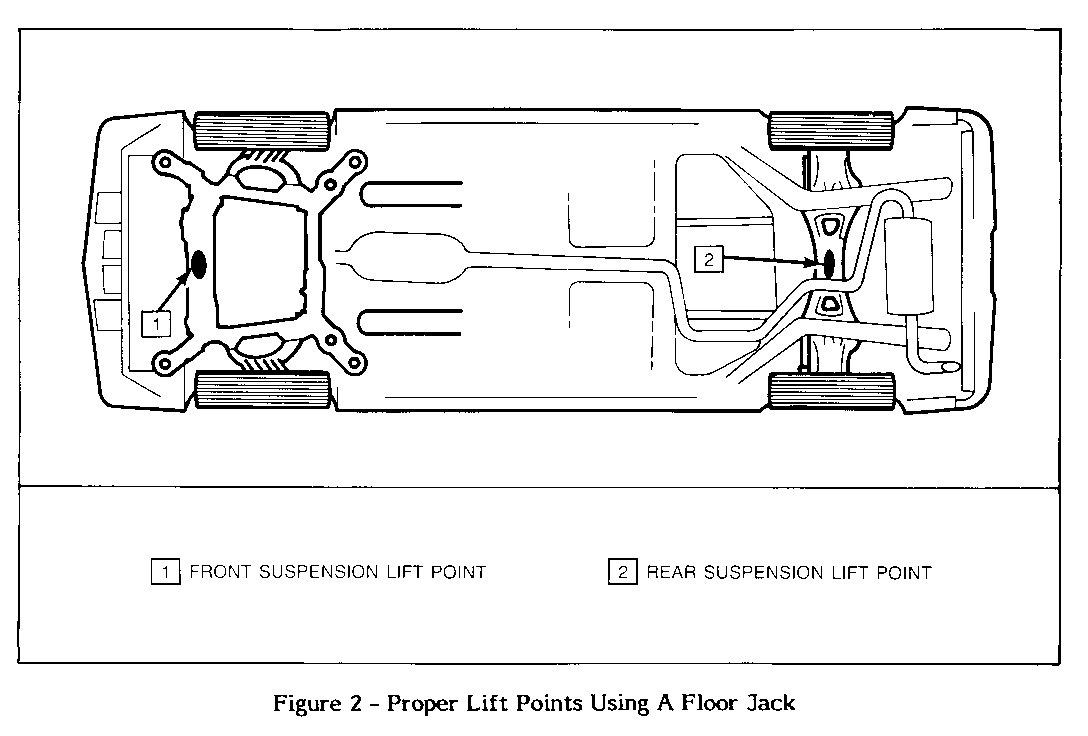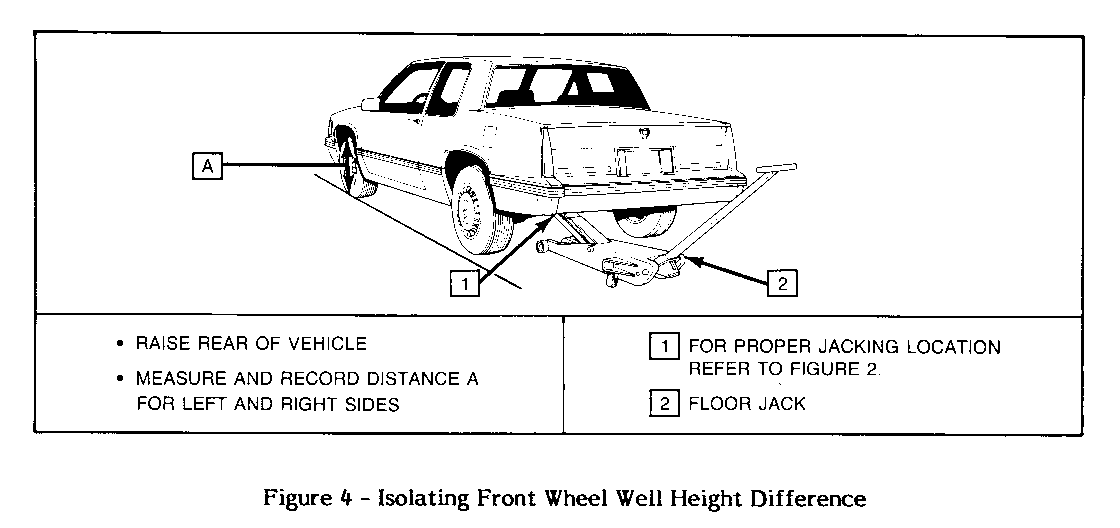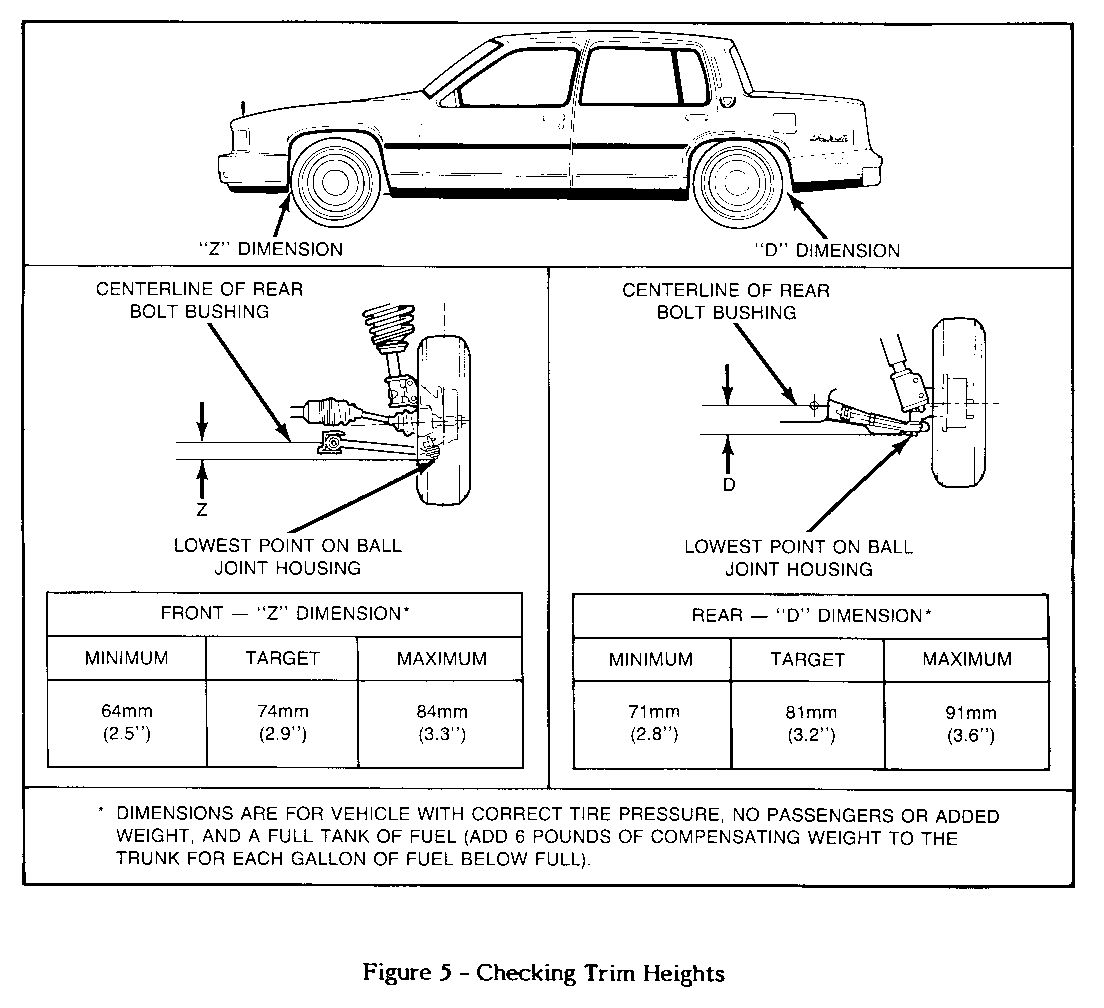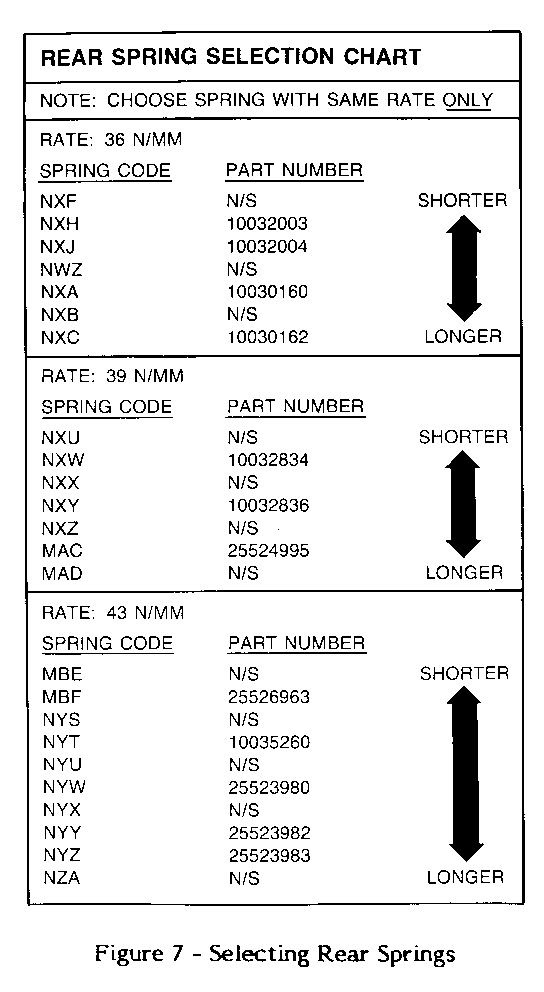VEHICLE LEANS ON LEFT SIDE DE VILLE AND FLEETWOOD

MODELS AFFECTED: 1985-1987 DE VILLES AND FLEETWOODS
Some 1985-1987 De Villes and Fleetwoods may appear to lean to the left. To permit uniform spring selection, De Villes and Fleetwoods are designed with a slight lean to the left. This is not enough to be visibly apparent to most owners. Because of tolerance stack ups, however, some vehicles may lean to the left and result in an owner comment. Tolerance stack ups to the right will reduce the "designed in" lean to the left. Therefore, comments of leans to the right are not likely. If an owner comments of a left lean, new springs can be selected and installed as outlined in this bulletin to repair the vehicle.
Verifying Owner Complaint
With the vehicle on a level surface, measure heights at the wheel well opening, see Figure 1. If the difference in measurements from the left to right side (front or rear) is 1/4 inch or less, following the procedures in this butletin will not level the vehicle. It will only shift the lean to the right. Under these conditions, the owner should be told that the lean is within design specifications.
If the difference is greater than 1/4 inch, use the following procedure to diagnose and repair the condition.
Initial Checks
o Check tire pressures using the specifications given on the tire placard located on the driver's door. Adjust pressures as necessary.
o Check for a tight or sticking front or rear suspension. With the aid of a helper, push down on the rear of the vehicle and release. Allow vehicle to settle and measure rear wheel well opening heights, see Figure 1. With the aid of a helper, lift the rear of the vehicle and release. Allow the vehicle to settle and measure rear wheel well opening heights. If the height is not within 1/2 inch of the first measurement, check for tight, sticking or binding suspension components. Loosen all suspension components and torque to proper specifications given in Section 3 of the appropriate Service Information Manual. Repeat test. If height is stitl not within 1/2 inch, check for a sticking strut assembly by replacing the strut assembly. Repeat this procedure for the front suspension.
Isolating the Lean to the Front or Rear Suspension
Measuring the wheel well opening heights may be different at either the front or rear only. However, front and rear springs do interact and it is necessary to isolate the lean to the front and rear of the vehicle.
To isolate the rear suspension, raise the front of the vehicle using a floor jack (see Figure 2 for proper jack location). Measure and record heights at the rear wheel wells as shown in Figure 3. Repeat for the front suspension by supporting the rear suspension (see Figure 2 for proper jack location). Measure and record heights at the front wheel wells as shown in Figure 4. Springs should be selected for the end of the vehicle with the greater difference in left and right wheel well opening heights.
Check Bumper Heights
Remove everything except jack and spare tire assembly from the trunk. Make sure vehicle has a full tank of fuel or add compensating weight ( one gallon of fuel weighs approxiamately 6 pounds). Set tire pressures, refer to tire placard on the rear face of the driver's door. Jounce front and rear of vehicle. Check bumper heights as outlined in Figure 8.
Check Headlight Alignment
Check headlight alignment and adjust if necessary.
Check Front and Rear Suspension Alignment
Check front and rear suspension alignment using the specifications listed in Section 3A of the appropriate Service Information Manual.
Checking Trim Heights
There are two choices when selecting springs to correct a lean: one is to replace the taller spring with a shorter spring, the other is to replace the shorter spring with a taller spring. To correctly make this choice, the trim heights should be checked, see Figure 5. If the trim height is at the low end of the specification, the shorter spring should be replaced with a taller spring; if the trim height is at the high end of the specification, the taller spring should be replaced by a shorter spring.
Selecting A Spring
Identify the spring installed on the vehicle by locating the tag on the spring and recording the spring code. Select a new shorter or longer spring with the same "rate" as the original spring. The spring available through service closest in length to original spring should be selected. Refer to Figure 6 for front springs and Figure 7 for rear springs.
Recheck Trim Heights
Install springs and recheck trim heights.








General Motors bulletins are intended for use by professional technicians, not a "do-it-yourselfer". They are written to inform those technicians of conditions that may occur on some vehicles, or to provide information that could assist in the proper service of a vehicle. Properly trained technicians have the equipment, tools, safety instructions and know-how to do a job properly and safely. If a condition is described, do not assume that the bulletin applies to your vehicle, or that your vehicle will have that condition. See a General Motors dealer servicing your brand of General Motors vehicle for information on whether your vehicle may benefit from the information.
